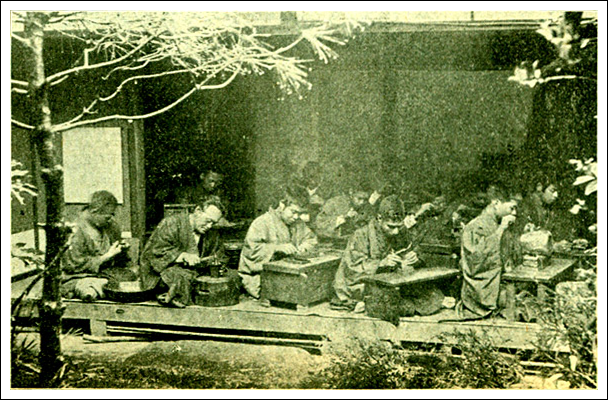
Komai, Otojiro [駒井音次郎 / 駒井音治郎] (1842 ~ 1917)

Otojiro Komai

Otojiro Komai's workshop, Furumonzen street, Kyoto.

Artisans in the Otojiro Komai's workshop.

Artisans in the Otojiro Komai's workshop.

O. Komai's exhibition booth at the Panama-Pacific Exposition (1915).

Evolution of the O. Komai trade mark, based on the advertisements (see the "Advertisements" section below) and dated works (clickable blue-colored links). During the 1885~1894 period (grey-colored) Otojiro Komai worked for S. Ikeda and couldn't sign his works with his mark.
Addresses and locations
No. 33 Furumonzen (古門前), Nichome (2-chome), Kyoto.
No. 262 Shinmonzen (新門前), Kyoto.
Shinsaibashi Kitazume, Osaka.
Miyako Hotel branch, Kyoto.
Imperial Hotel Arcade, Tokyo.
Exhibitions
Participated in the following exhibitions (incomplete list):
1903: The Fifth National Industrial Exhibition (Osaka, Japan). Prize Medal.
1904: Louisiana Purchase Exposition (Saint Louis, USA). Was awarded the Gold Medal.
1905: Lewis and Clark Centennial Exposition (Portland, USA). Gold Medal.
1905: Liege International (Liege, Belgium). Diplome D'Honneur.
1908: Exhibition of Modern Trends in Art (Saint Petersburg, Russia). Gold Medal.
1909: Alaska–Yukon–Pacific Exposition (Seattle, USA). Grand Prix.
1910: Japan-British Exhibition (London, Great Britain). Gold Medal.
1910: Brussels International (Brussels, Belgium). Hors Concours.
1913: 45th Secession Exhibition (Wien, Austria). Gold Medal.
1914: Colonial Exhibition of Semarang (Semarang, Dutch East Indies / Indonesia). Gold Medal.
1914: Tokyo Taisho Exhibition (Tokyo, Japan).
1915: Panama-Pacific International Exposition (San Francisco, USA). Diplome D'Honneur.
1923: The Independence Centenary Internat. Exposition (Rio de Janeiro, Brazil). Hors Concours.
1925: International Exhibition of Modern Decorative and Industrial Arts (Paris, France). Gold Medal.
1926: Sesqui-Centennial International Exposition (Philadelphia, USA). Gold Medal & Silver Medal.
Exposition record |
Louisiana (1904) Exposition |
Exposition record |
Exhibition record (Translation) |
Exposition record |
Panama-Pacific (1915) Exposition |
Decorative and Industrial Arts (1925) record |
Exposition record |
Marks
日本國西京住駒井製
Nihon koku Saikyo ju Komai sei
Made by Komai from Saikyō, Great Japan
日本國京都住駒井製
Nihon koku Kyoto ju Komai sei
Made by Komai from Kyoto, Great Japan
日本国京都住駒井製
Notice that the only difference from the mark above is the replacement 國 → 国. Kanji 国 is the simplified form of 國 and is equivalent to it.
The dragonfly had different variations: from highly elaborated, with four wide wings (during 1903 ~ 1915) to simple and primitive, with wings and body made of 5 straight gold wires (during 1930s).
Decorative arts made for export in 1930s were additionally marked with a "JAPAN" inscription.
Early marks of the Komai family business
京都 (Kyoto) 駒井 (Komai) 信樂 (Shigaraki) 堂 (hall) 製 (make)
Kyoto Komai Shigaraki do sei
Made by Komai of Kyoto in Shigaraki hall
The outside circle reads 大日本京都駒井製:
大日本 (Great Japan) 京都 (Kyoto) 駒井 (Komai) 製 (make)
Dai Nihon Kyoto Komai sei = Made by Komai, Kyoto, Great Japan
Advertisements
(Translation) |
Business cards
Records from old books
Examples provided by contributors
|
Left: A flock of cranes above the galleon at the sea with Mt. Fuji on the back.
Right: A pair of pheasants near the lake. Butterflies, irises and peonies on the background. Circa 1894 ~ 1902. From the collection of Richard Nadolny. |
Outside: Full coverage of the case's surface by the Sayagata, a traditional Japanese pattern.
Inside: Chrysanthemums, traditional Japanese flowers, on a black lacquer background. Circa 1908 ~ 1913. From the collection of Chris Penry. |














































































































































































